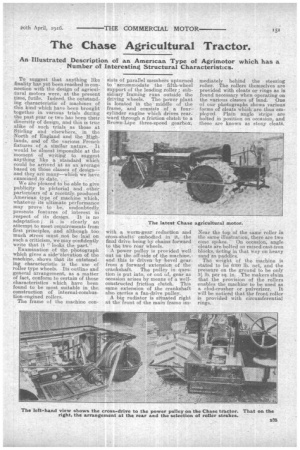The Chase Agricultural Tractor.
Page 9

If you've noticed an error in this article please click here to report it so we can fix it.
An Illustrated Description of an American Type of Agrimotor which has a Number of Interesting Structural Characteristics.
To suggest that anything like finality has yet been reached in connection with the design of agricultural motors were, at -the present time, futile. Indeed, the outstanding characteristic of machines of this kind' which have been brought together in various trials during the past year or two has been their diversity of design, and this is true alike of such trials as those at Stirling and elsewhere, in the Nerth of England and the Highlands, and of the various French fixtures of .a similar nature. It would be almost inipossible at the moment of writipg to suggest anything like a . standard which could be arrived at as ah aVerage, based on those classes of design— and they are many—which we have examined ,to date. . .
We are pleased to be able to give publicity to pictorial: and other particulars of a reeently produced American type of machine which, whatever its ultimate performance may prove to be, undoubtedly, presents features of interest in respect of its design. It is no adaptation; it isclearly an attempt to meet requirements from first principles, and although toomuch stress natist .not, be laid on such a criticism, we may confidently. write that it "looks the part."
Examination of the -photograph which gives a side-eleVation of the machine, shows that its outstanding characteristic is the use of roller type wheels. Its outline and general arrangement, as a matter of fact, conform to certain of those characteristics which have been found to be most suitable in the construction of internal-combustion-engined rollers. The frame of the machine con
sists of parallel members upturned to 'accommodate the fifth-wheel support of the leading roller ; subsidiary framing runs outside the driving wheels. The power plant is located in the• middle of the frame, and consists of a fourcylinder engine which drives rear-ward through a friction clutch to a Brown-Lipe three-speed gearbox, with a worm-gear reduction and cross-shafts embodied in it, the final drive being by chains forward to the two rear wheels.
A power pulley is provided well out on the off-side of the machine,' and this -is driven by bevel gear, from a forward extension of the crankshaft. The pulley in question is put into, or out of, gear as occasion arises by means of a wellconstructed friction clutch. This same extension of the crankshaft also carries a fan-drive pulley. A big radiator is situated right at the front of the main frame mediately behind the steering roller. The rollers themselves are provided with cleats or rings as is found necessary when operating on the various classes of land. One of our photographs shows various forms of cleats which are thus employed. Plain angle strips are bolted in position on occasion, and these are known as stony cleats.
Near the top of the same roller in the same illustration, there are two cOne spikes. On occasion, angle cleats are bolted on raised cast-iron blocks, acting in that way on heavy
sand as paddles. , The weight of the machine is Stated to be 6000 lb. net, and the pressure on the ground to be only 31 lb. per sq. in. The makers claim that the provision of the rollers enables the machine to be used as a clod-crusher or pulverizer. It will be noticed that the front roller is provided with circumferential rings.






















